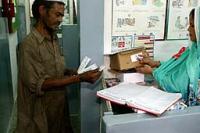
A review carried out by the 2009 Reference Group to the UN on HIV and Injecting Drug Use concludes that coverage of HIV prevention, treatment, and care services for injecting drug users (IDUs) worldwide is very low and unlikely to be sufficient to prevent, halt, or turn around HIV epidemics. Credit: UNAIDS/P.Virot
A review carried out by the 2009 Reference Group to the UN on HIV and Injecting Drug Use for the first time quantifies the scale of coverage of HIV prevention, treatment, and care services for injecting drug users (IDUs) worldwide. The study concludes that with, specific exceptions, worldwide coverage of these services in IDU populations is very low and unlikely to be sufficient to prevent, halt, or turn around HIV epidemics.
The paper, published by The Lancet in its online edition of 1 March 2010, also highlights the need for improved data collection on injecting drug users in each region in order to get a clearer picture of the extent of their needs. “We still do not know enough about the nature and size of the populations we need to target.”
We know that a mix of actions directed to reducing the harms associated with drug use can reduce the number of new HIV infections among drug users to practically zero.
UNAIDS Executive Director Michel Sidibé
Already the gaps in services are apparent. In prevention, the study estimates that two needles per month were distributed per person who injects drugs. In the countries that estimate the number of condoms distributed to IDUs, an average of 12 condoms were distributed to each IDU per year.
These global averages hide even greater regional and national variations in services.
While nearly all countries in western and eastern Europe, central Asia, Australasia, and North America had needle and syringe programmes (NSPs), these services aren’t present in nine of 25 countries in east, southeast, and south Asia where injecting drug use occurs. NSPs were also absent or unreported in 14 of the 16 countries in sub-Saharan Africa where injecting drug use occurs.
Opioid substitution therapy (OST) coverage also varied from 1% or less of IDUs in central Asia, Latin America, and sub-Saharan Africa, to very high levels of 61% in western Europe.
Access to services for all drug users
UNAIDS believes that drug users can be protected from becoming infected with HIV if comprehensive, evidence-informed and human-rights-based interventions are made accessible to all drug users.
“Effective harm reduction approaches include access to clean needles, opioid substitution therapy for opiate users, access to antiretroviral therapy and reducing sexual transmission of HIV from drug users to their sexual partners through condom promotion,” said UNAIDS Executive Director Michel Sidibé. “But current coverage of these services is appallingly low.”
The study was funded by the UN Office on Drugs and Crime (UNODC), Australian National Drug and Alcohol Research Centre, University of New South Wales; and Australian National Health and Medical Research Council.




 A review carried out by the 2009 Reference Group to the UN on HIV and Injecting Drug Use concludes that coverage of HIV prevention, treatment, and care services for injecting drug users (IDUs) worldwide is very low and unlikely to be sufficient to prevent, halt, or turn around HIV epidemics. Credit: UNAIDS/P.Virot
A review carried out by the 2009 Reference Group to the UN on HIV and Injecting Drug Use concludes that coverage of HIV prevention, treatment, and care services for injecting drug users (IDUs) worldwide is very low and unlikely to be sufficient to prevent, halt, or turn around HIV epidemics. Credit: UNAIDS/P.Virot